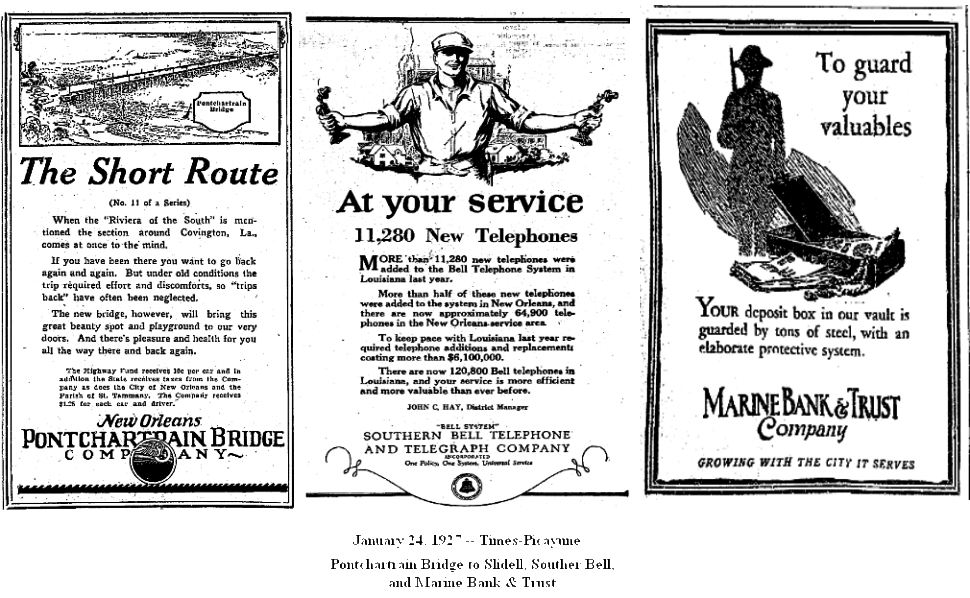|
Today in New Orleans History |
|
|
January 24


 Three
times since 1928, New Orleanians were able to claim having the world’s longest bridge. When the advertised New
Orleans Pontchartrain Bridge (also known as the “Five Mile Bridge”, the "Watson-Williams, the Pointe Aux
Herbes, and the Maestri Bridge) was completed in 1928, it was considered to be the "World's Longest Continuous Concrete
Highway Bridge". The claim as “world’s longest” would later be made by The Causeway – first
when the original bridge opened and later when the second span was added. In1911 Eli Watson built a mansion in the 400 block of Metairie Road. In 1926 he owned the Metairie
Theater off Metairie Road near the railroad tracks. In 1928 (the year after he reigned as Rex), he built and owned
this first bridge across Lake Pontchartrain. At a cost of $5,000,000, it was later named the Watson-Williams Bridge for his
company of investment bankers headed by him and his partner George Williams. This Bridge is part of the "Old Spanish
Trail," from Palm Beach, Florida, to Los Angeles, California ( Route U.S. No. 90) which brings New Orleans over the lake
to Pointe Aux Herbes (not Covington, as implied in the advertisement). While the adjacent modern I-10
Twin Span crumbled under the stress of Hurricane Katrina, this old bridge survived relatively unscathed
and is still in use today. Converted to 1955 to FOrest 1 & 6 1937 to MAgnolia, plus four digits ~~~~~ The Marine Bank & Trust Co. was organized in 1918 at 704 Common St. in the St.
Charles Hotel building. Its first president, former Hibernia Bank Vice-president L.M. Pool "nearly got writer's cramp
signing up the subscribers," wrote the Morning Tribune, "who came in faster than he had ever dreamed."
In 1921, the bank took a 20 year lease on the entire lower floor of the Cotton Exchange. But in 1928, they merged with
Canal Bank & Trust. (NOPL)  

To receive an update for each day in New Orleans
history, join our facebook page
- Today in New Orleans History
The Saints defeated the Minnesota Vikings, 31-28 in overtime, to win their first-ever home NFC Championship
Game on January 24, 2010. The team moved on to win Super Bowl XLIV in Miami.
Isidore "Tuts" Washington, born in New Orleans on January 24, 1907, was
a blues pianist who exemplified the New Orleans rhythm and blues style, also made famous by musicians such as Professor Longhair.
Washington taught himself piano at age 10, and studied with New Orleans jazz pianist Joseph Louis "Red" Cayou. In
the 1920s and 1930s, he was a leading player for New Orleans dance and Dixieland bands. His unique style of play blended elements
of ragtime, jazz, blues, and boogie-woogie. After World War II, Washington joined the band of singer/guitarist Smiley Lewis;
they released several well-known songs on Imperial Records including "Tee-Nah-Nah," "The Bells Are Ringing"
and "Dirty People." He then moved to St. Louis to play with Tab Smith. He returned to New Orleans in the 1960s,
continuing to appear at restaurants in the French Quarter, clubs such as Tipitina's, and at the New Orleans Jazz & Heritage
Festival. For years he had a regular gig playing piano at a bar in the Pontchartrain Hotel. Although he avoided recording
for most of his career, he released the solo piano album New Orleans Piano Professor on Rounder Records in 1983.
Tuts Washington died on August 5, 1984, after suffering a heart attack while performing at the World's Fair in New Orleans.
In 1998, Night Train International Records released a live recording by Washington, Live at Tipitina's '78.
The New Orleans Cotton Exchange was founded in 1871. Its constitution, adopted on January
24 of that year, stated the organization's purposes as:...to provide and maintain suitable rooms for a "Cotton
Exchange" in the City of New Orleans; to adjust controversies between members; to establish just and equitable
principles, uniform usages, rules and regulations, and standards for classification, which shall govern all transactions
connected with the cotton trade: to acquire, preserve and disseminate information connected therewith; to decrease
the risks incident thereto; and generally to promote the interests of the trade, and increase the facilities and
the amount of the cotton business in the City of New Orleans.
|
||||||||||||||||||||||||||||||||||||||||
|

To receive an update for each day in New Orleans history,
join our facebook page - Today in New
Orleans History.
Analytics |


